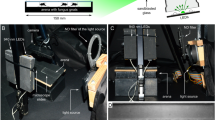Abstract
The phototactic response of the rice weevil, Sitophilus oryzae (L.), to light-emitting diodes (LEDs) at five different wavelengths and various light intensities was tested in an LEDequipped Y-maze chamber, and compared with its response to a luring lamp, which is used in commercial traps. Blue (84.3%) was the wavelength most attractive to S. oryzae, followed by green (74.3%), red (64.3%), UV (63.3%), and IR (48.7%). Moreover, blue and green wavelengths were 1.5 and 1.3 times more attractive than luring lamp (56.7%), whereas the UV wavelength was slightly less attractive to the weevils than luring lamp. These results suggested that blue and green wavelengths could be more useful than those currently used for monitoring and mass trapping of S. oryzae.
Similar content being viewed by others
References
Ahn YJ, Lee SB, Lee HS, and Kim GH (1998) Insecticidal and acaricidal activity of carvacrol and â-thujaplicine derived from Thujopsis dolabrata var. hondai sawdust. J Chem Ecol 24, 81–90.
Antignus Y (2000) Manipulation of wavelength-dependent behavior of insects: An IPM tool to impede insects and restrict epidemics of insect-borne viruses. Virus Res 71, 213–220.
Athanassiou CG, Papagregoriou AS, and Buchelos CTH (2004) Insecticidal and residual effect of three pyrethroids against Sitophilus oryzae (L.) (Coleoptera: Curculionidae) on stored wheat. J Stored Prod Res 40, 289–297.
Bentley MT, Kaufman PE, Kline DL, and Hogsette JA (2009) Response of adult mosquitoes to light-emitting diodes placed in resting boxes and in the field. J Am Mosquito Contr 25, 285–291.
Blackmer JL and Canas LA (2005) Visual cues enhance the response of Lygus hesperus (Heteroptera: Miridae) to volatiles from host plants. Environ Entomol 34, 1524–1533.
Chu CC, Jackson CG, Alexander PJ, Karut K, and Henneberry TJ (2003) Plastic cup traps equipped with light-emitting diodes for monitoring adult Bemisia tabaci (Homoptera: Aleyrodidae). J Econ Entomol 96, 543–546.
Dal Bello G, Padin S, Lopez Lastra C, and Fabrizio M (2001) Laboratory evaluation of chemical-biological control of the rice weevil (Sitophilus oryzae L.) in stored grains. J Stored Prod Res 37, 77–84.
Gjullin CM, Brandl DG, and O’Grady JJ (1973) The effect of colored lights and other factors on the numbers of Culex pipiens quinquefasciatus, Cx. Tarsalis and Aedes sierrensis entering light traps. Mosq New 33, 67–71.
Hausmann C, Samietz J, and Dorn S (2004) Visual Orientation of Overwintered Anthonomus pomorum (Coleoptera: Curculionidae). Environ Entomol 33, 1410–1415.
Hoel DF, Butler JF, Fawaz EY, Watany N, El-Hossary SS, and Villinski J (2007) Response of phlebotomine sand flies to light-emitting diode-modified light traps in southern Egypt. J Vector Ecol 32, 302–308.
Kim SI, Yoon JS, Jung JW, Hong KB, Ahn YJ, and Kwon HW (2010) Toxicity and repellency of origanum essential oil and its components against Tribolium castaneum (Coleoptera: Tenebrionidae) adults. J Asia Pac Entomol 13, 369–373.
Michaelraj S and Sharma RK (2006) Fumigant toxicity of neem formulations against Sitophilus oryzae and Thyzopertha dominica. J Agric Technol 2, 1–16.
Mutwiwa UN and Tantau HJ (2005) Suitability of a UV lamp for trapping the greenhouse whitefly Trialeurodes vaporariorum Westwood (Hom: Aleyrodidae). The CIGR Ejournal 7, 1–11.
Nakakita H and Ikenaga H (1997) Action of low temperature on physiology of Sitophilus zeamais Motschulsky and Sitophilus oryzae (L.) (Coleoptera: Curculionidae) in rice storage. J Stored Prod Res 33, 31–38.
Nakamoto Y and Kuba H (2004) The effectiveness of a green light emitting diode (LED) trap at capturing the west indian sweet potato weevil, Euscepes postfasciatus (Fairmaire) (Coleoptera: Curculionidae) in a sweet potato field. Appl Entomol Zool 29, 491–495.
Oh MS and Lee HS (2010) Development of phototactic test apparatus equipped with light source for monitoring pests. J Appl Biol Chem 53, 248–252.
Papadopoulou SCH and Buchelos CTH (2002) Comparison of trapping efficacy for Lasioderma serricorne (F.) adults with electric, pheromone, food attractant and control-adhesive traps. J Stored Prod Res 38, 375–383.
Park IK, Lee HS, Lee SG, Park JD, and Ahn YJ (2000) Insecticidal and fumigant activities of Cinnamomum cassia bark-derived materials against Mechoris ursulus (Coleoptera: Attelabidae). J Agric Food Chem 48, 2528–2531.
Plarre R (1996) Three-dimensional distribution of Sitophilus granaries (L.) (Coleoptera: Curculionidae) in wheat influenced by the synthetic aggregation pheromone. J Stored Prod Res 32, 275–283.
Sambaraju KR and Phillips TW (2008) Responses of adult Plodia interpunctella (Hubner) (Lepidoptera: Pyralidae) to light and combinations of attractants and light. J Insect Behav 21, 422–439.
Tamulaitis G, Duchovskis P, Bliznikas Z, Breivë K, Ulinskaitë R, Brazaitytë A, Novièkovas A, and Pukauskas A (2005) High-power light-emitting diode based facility for plant cultivation. J Phys D: Appl Phys 38, 3182–3187.
Yeh N and Chung JP (2009) High-brightness LEDs-Energy efficient lighting sources and their potential in indoor plant cultivation. Renew Sust Energ Rev 13, 2175–2180.
Author information
Authors and Affiliations
Corresponding author
Rights and permissions
About this article
Cite this article
Jeon, JH., Oh, MS., Cho, KS. et al. Phototactic response of the rice weevil, Sitophilus oryzae linnaeus (Coleoptera: Curculionidae), to light-emitting diodes. J Korean Soc Appl Biol Chem 55, 35–39 (2012). https://doi.org/10.1007/s13765-012-0006-3
Received:
Accepted:
Published:
Issue Date:
DOI: https://doi.org/10.1007/s13765-012-0006-3




